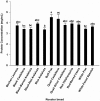Seminal plasma amino acid profile in different breeds of chicken: Role of seminal plasma on sperm cryoresistance
- PMID: 30608977
- PMCID: PMC6319765
- DOI: 10.1371/journal.pone.0209910
Seminal plasma amino acid profile in different breeds of chicken: Role of seminal plasma on sperm cryoresistance
Abstract
Seminal plasma is a key biological fluid that modulates sperm function in the reproduction process. However, its role in sperm biotechnologies is scarce in poultry. The aims of the present study were to study the amino acids profile and total proteins of seminal plasma in 12 Spanish chicken breeds and to investigate the role of seminal plasma on cryoresistance of rooster sperm. To investigate the role of seminal plasma on cryoresistance, diluted pooled semen samples were cryopreserved in the presence and absence of seminal plasma. Glutamic acid was the most abundant free amino acid in seminal plasma, followed by alanine, serine, valine, and glycine. There was an influence of breed (P<0.05) on the percentage of viable sperm after freezing-thawing of samples with seminal plasma. Cluster analysis revealed that White Prat, Black Castellana, Blue Andaluza, Quail Castellana, and Red-Barred Vasca returned the best freezing-thawing response (good freezers). There was a positive correlation between seminal plasma concentrations of valine, isoleucine lysine, leucine and post thaw viability. The evaluation of fertilization capacity of frozen-thawed semen from the breeds White Prat ('good freezer') and Black-Red Andaluza ('bad freezer') showed that good freezer had higher fertility (20/68, 29.4%) compared to bad freezer breed (14/76, 18.4%), even if the difference was not significant (P = 0.08). The TUNEL assay revealed that freezing/thawing procedures in presence of seminal plasma provoked higher DNA fragmentation in most of the breeds, with a positive correlation between seminal alanine, valine, isoleucine, methionine, leucine, tyrosine, phenylalanine concentrations and DNA integrity. DNA fragmentation was lower in absence of seminal plasma and the breed effect on sperm viability was highly reduced. It is concluded that specific seminal plasma amino acids were associated with post-thaw percentage of viable sperm and DNA integrity. The removal of seminal plasma decreases the variability of the results and DNA fragmentation damages.
Conflict of interest statement
The authors have declared that no competing interests exist.
Figures






Similar articles
-
Functional Aspects of Seminal Plasma in Bird Reproduction.Int J Mol Sci. 2020 Aug 7;21(16):5664. doi: 10.3390/ijms21165664. Int J Mol Sci. 2020. PMID: 32784638 Free PMC article. Review.
-
Effect of supplementation of valine to chicken extender on sperm cryoresistance and post-thaw fertilization capacity.Poult Sci. 2020 Dec;99(12):7133-7141. doi: 10.1016/j.psj.2020.09.060. Epub 2020 Oct 7. Poult Sci. 2020. PMID: 33248630 Free PMC article.
-
Dialysis of boar semen prior to freezing-thawing: its effects on post-thaw sperm characteristics.Theriogenology. 2007 Mar 15;67(5):994-1003. doi: 10.1016/j.theriogenology.2006.12.002. Epub 2007 Jan 10. Theriogenology. 2007. PMID: 17218000
-
Thawing boar semen in the presence of seminal plasma improves motility, modifies subpopulation patterns and reduces chromatin alterations.Reprod Fertil Dev. 2017 Aug;29(8):1576-1584. doi: 10.1071/RD15530. Reprod Fertil Dev. 2017. PMID: 27543989
-
Potential of seminal plasma to improve the fertility of frozen-thawed boar spermatozoa.Theriogenology. 2019 Oct 1;137:36-42. doi: 10.1016/j.theriogenology.2019.05.035. Epub 2019 May 31. Theriogenology. 2019. PMID: 31200934 Review.
Cited by
-
Seminal plasma metabolomics analysis of differences in liquid preservation ability of boar sperm.J Anim Sci. 2023 Jan 3;101:skad392. doi: 10.1093/jas/skad392. J Anim Sci. 2023. PMID: 38006391 Free PMC article.
-
Sperm Cryopreservation in American Flamingo (Phoenicopterus Ruber): Influence of Cryoprotectants and Seminal Plasma Removal.Animals (Basel). 2021 Jan 15;11(1):203. doi: 10.3390/ani11010203. Animals (Basel). 2021. PMID: 33467758 Free PMC article.
-
Functional Aspects of Seminal Plasma in Bird Reproduction.Int J Mol Sci. 2020 Aug 7;21(16):5664. doi: 10.3390/ijms21165664. Int J Mol Sci. 2020. PMID: 32784638 Free PMC article. Review.
-
Use of native chicken breeds (Gallus gallus domesticus) for the development of suitable methods of Cantabrian capercaillie (Tetrao urogallus cantabricus) semen cryopreservation.Vet Med Sci. 2022 May;8(3):1311-1318. doi: 10.1002/vms3.742. Epub 2022 Apr 14. Vet Med Sci. 2022. PMID: 35419978 Free PMC article.
-
Incorporation of Biotechnologies into Gene Banking Strategies to Facilitate Rapid Reconstitution of Populations.Animals (Basel). 2023 Oct 11;13(20):3169. doi: 10.3390/ani13203169. Animals (Basel). 2023. PMID: 37893893 Free PMC article.
References
-
- Berger T, Clegg E. Effect of male accessory gland secretions on sensitivity of porcine sperm acrosomes to cold shock. Initiation of motility and loss of cytoplasmic droplets. J. Anim. Sci. 1985; 60 (5):1295–1302. - PubMed
-
- Pérez-Pé R, Cebrián-Pérez JA, Muiño-Blanco T. Semen plasma proteins prevent cold-shock membrane damage to ram spermatozoa. Theriogenology. 2001; 56(3):425–434. - PubMed
-
- Caballero I, Parrilla I, Almiñana C, del Olmo D, Roca J, Martínez EA, et al. Seminal plasma proteins as modulators of the sperm function and their application in sperm biotechnologies. Reprod Dom Anim. 2012; 47 (Suppl. 3):12–21. - PubMed
Publication types
MeSH terms
Substances
LinkOut - more resources
Full Text Sources
Research Materials

